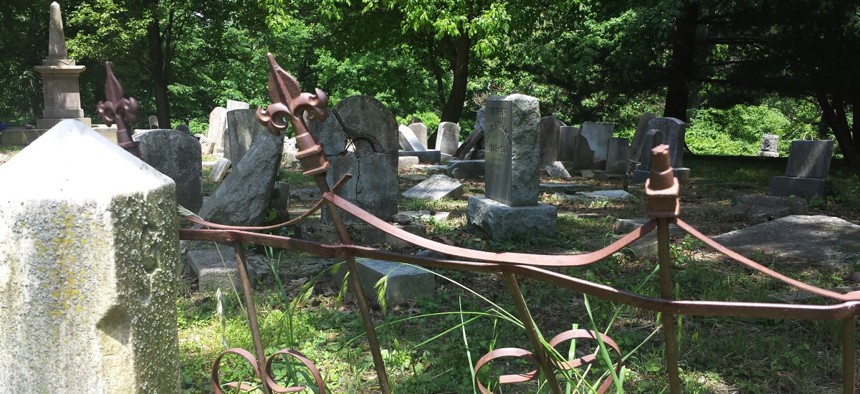Good Ways to Activate the Nation’s Neglected Local Cemeteries

Mt. Zion Cemetery in Washington D.C.'s Georgetown neighborhood. Michael Grass / RouteFifty.com

Connecting state and local government leaders
Some examples of how the living can transform a domain of the dead into a valued community asset.
WASHINGTON — Tucked away on the edge of the Georgetown neighborhood around the corner from the historic Dumbarton House headquarters of the National Society of the Colonial Dames of America, there’s an old cemetery that time has mostly forgotten about.
Make that two cemeteries: The Old Methodist Burying Ground and the Female Union Band Society Graveyard, which share roughly 3 acres of land perched on a wooded bluff above Rock Creek Park.
Collectively, these two final resting spots are known today as Mount Zion Cemetery, “a physical reminder of African American life and the evolving free black culture in the District of Columbia from the earliest days of the city to the present,” according to a National Park Service website profiling historic sites in the nation’s capital.
While Mount Zion isn’t abandoned, it’s certainly neglected and has been for a long time . Plenty of grave markers have disappeared over the years. Many of the ones that remain are toppled over, are worn down or are stacked in clusters.
The Mount Zion Church , which has nearly 200 years of history in Georgetown and served the large African-American population that once lived in the neighborhood, owns the land and has been trying to figure out ways to restore the cemetery, but according to The Georgetowner , restoration costs could come with a six-figure price tag .
There are countless neglected cemeteries around the nation—some that are under municipal jurisdiction and many others under the stewardship of religious institutions or non-profit organizations—that are just like Mount Zion, where funding long-term upkeep is a huge struggle and the risk of sustained neglect is very real.
But there are creative solutions that can help some cemeteries get the resources they need that also help give new life to these final resting spots.
Across town at the far eastern edge of Capitol Hill, historic Congressional Cemetery offers an interesting case study of what a cemetery can be.
While there are members of Congress buried in the roughly 65,000 grave sites—along with other notable figures like J. Edgar Hoover and John Philip Sousa—this National Historic Landmark isn’t run by any government. It’s run by the Association for the Preservation of Historic Congressional Cemetery , which has helped maintain the cemetery and rescued it from major neglect.
In some ways, the cemetery is also the domain of neighborhood canines. Membership fees from neighborhood dog walkers have helped fund upkeep at the cemetery over the years, transforming the 35-acre site from an overgrown, neglected landscape that once attracted plenty of drug users and other nefarious activities to one that’s now one of the crown jewels of the local community.
Beyond the K9 Corps dog walking memberships, the cemetery raises funds through special events. That included a recent outdoor movie night that sparked a testy letter to the editor in The Washington Post . The letter writers asked: “Have we lost all sense of decency and respect for our families and ancestors that we would defile so sacred a place?”
It’s a fair question, but the group that runs Congressional Cemetery has heard such complaints before.

Just last week, the association that runs Congressional outlined why it’s important to have a living and active cemetery . For starters, it comes down to money, where donations and special events are needed to supplement income from burials and funerals: “Without these contributions, the cemetery would not be in the condition that it is in today, and the non-profit would not be able to continue to preserve and interpret this National Historic Landmark.”
Additionally, in the Victorian era, cemeteries were often viewed as vibrant public spaces: “Instead of being viewed solely as final resting places, cemeteries such as Congressional earned mention in tourist guidebooks and became gathering places for weekend outings.”
Having famous and historically interesting people buried in a cemetery certainly helps gin up interest.
In Pineville, Louisiana, across the Red River from Alexandria, the historic Rapides Cemetery , hosted a fundraiser last month where six people dressed in period costumes played the roles of notable people buried in the gravesites.
Green-Wood Cemetery in Brooklyn, New York, long known for its who’s who of eternal residents, monument and mausoleum architecture and beautiful hilly arbored landscapes— plus its colony of wild blue-green Monk parakeets —has a robust offering of public programming.
That includes regular trolley tours, moonlight walking excursions and special events, including an upcoming “ Victorian extravaganza of performing arts ” that will “begin with a picnic around the beautiful pond Crescent Water, and will unfold into an evening of showmanship in front of [William] Niblo’s grand mausoleum.”
Not all cemeteries, of course, have the necessary elements to become noteworthy historic attractions. But they do show how a collection of gravesites doesn’t have to be just a domain for the dead. They can be wonderful community spaces for the living as well.
And as many urban cemeteries become filled to capacity with eternal residents, those who maintain them need to figure out ways to create sustaining community interest that will help fund long-term upkeep and prevent neglect.

NEXT STORY: Smart computers for the battlefield





